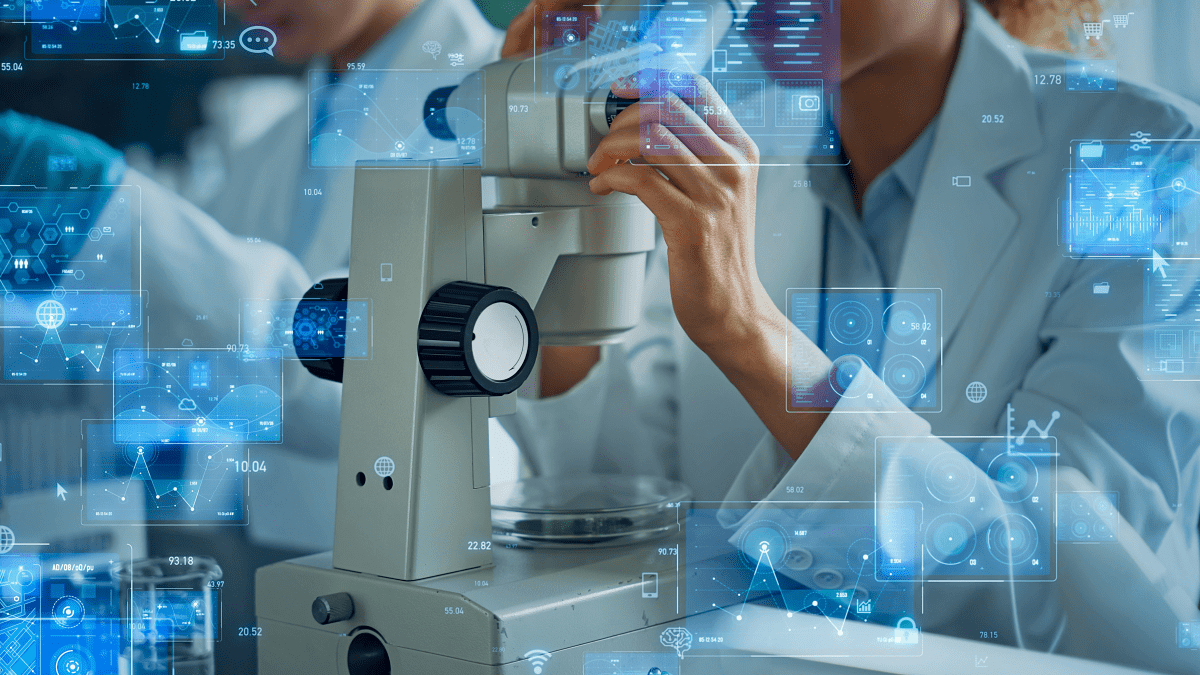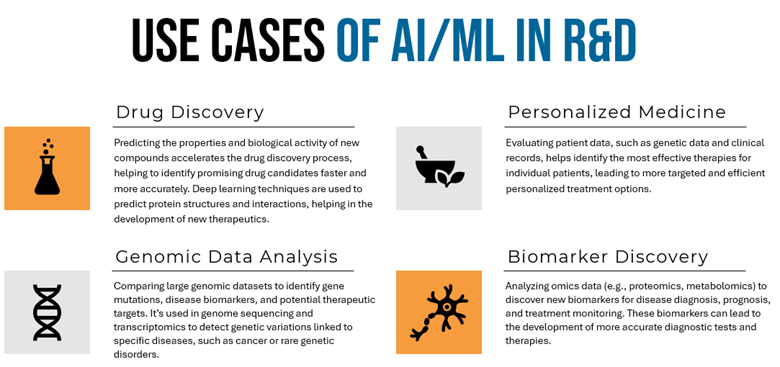
Key drivers behind the growing adoption of AI and ML in life science R&D
Welcome to part three of our series, Unlocking AI in the lab: Your 2025 Roadmap to Data Readiness & Scalable Innovation.
The rapid integration of Artificial Intelligence (AI) and Machine Learning (ML) in life science research and development (R&D) is reshaping the landscape of modern healthcare and pharmaceutical innovation. As the volume and complexity of biological data continue to grow, traditional methods are struggling to keep pace with the demand for faster, more accurate, and more personalized solutions. In response, AI/ML technologies are being increasingly adopted to meet these challenges—enhancing data analysis, streamlining workflows, and driving critical insights that fuel innovation.
What are the 6 Key drivers to AI in Life Science?
- Data Analysis and Pattern Recognition: ML algorithms excel at processing and analyzing large volumes of complex data to uncover hidden patterns and relationships that are not easily determined by traditional methods. This could include identifying biomarkers for disease, determining molecular properties, or predicting efficacy or toxicity. This approach accelerates the drug discovery process and reduces the need for costly and time-consuming experiments
- Predictive Modeling: AI/ML is used to create models that predict outcomes based on historical data, enabling researchers to anticipate the behavior of drug candidates before they undergo costly and time-consuming lab experiments. These models aid in identifying biomarkers, simulating biological systems, and optimizing manufacturing processes, making R&D more efficient, cost-effective, and tailored to individual patient needs.
- Optimization: Identifying and validating the appropriate biological target is one of the earliest and most critical steps in drug discovery. AI/ML can optimize this process by analyzing genomic, proteomic, and clinical data to uncover novel drug targets and validate their role in disease pathways. AI/ML plays an essential role in optimizing the design of new drug molecules and conducting virtual screening of large compound libraries. By predicting the biological activity of compounds, AI/ML helps prioritize those with the highest likelihood of success.
- Automating Tasks: AI/ML-based automation in R&D not only reduces the time spent on repetitive tasks but also ensures greater precision and consistency. By automating time-consuming tasks, researchers can expedite various phases of drug discovery and development, from early-stage discovery through to preclinical trials. AI-driven automation allows researchers to focus more on hypothesis generation, critical thinking, and high-level analysis, rather than spending time on routine tasks.
- Image and Signal Processing: AI/ML is a key technology for analyzing images and signals across research fields such as medical imaging, material science, and environmental monitoring. In life sciences, ML aids in interpreting complex medical images like MRI scans, X-rays, and histological slides, enhancing the detection of diseases like cancer with greater accuracy than traditional methods. These AI-driven tools improve the efficiency and reliability of image analysis, enabling faster, more precise diagnostics and the identification of abnormalities, driving better patient outcomes and research advancements.
- Natural Language Processing (NLP): In the field of NLP, AI, and ML are transforming into how large volumes of unstructured text data are analyzed, particularly in R&D. These AI-powered tools can automatically extract key findings, such as new discoveries, trends, and relevant data, from research papers, allowing scientists to stay up to date on the latest advancements without manually reviewing countless publications. NLP techniques also identify the relationships between different research topics, helping to uncover emerging trends and pinpoint potential research gaps.


Conclusion:
AI/ML technologies offer powerful tools for analyzing complex data, automating processes, and uncovering insights that would be too time-consuming or even impossible for humans to achieve on their own. The main factors driving the adoption of these tools include the growing complexity of data, the need for improved efficiency, and the rising demand for personalized solutions. AI/ML is being applied across R&D to accelerate discoveries, streamline drug development, and deliver faster, more accurate results—ultimately advancing the future of medicine and improving patient outcomes.
How Astrix Can Help
As the life sciences industry embraces AI/ML to drive discovery and innovation, organizations need more than just technology—they need a strategic partner who understands how to navigate complex scientific, regulatory, and technical landscapes.
Astrix helps life science companies unlock the full potential of AI/ML by ensuring their data, systems, and teams are ready to scale. Here’s how:
- Data Readiness & Infrastructure: We assess and optimize your data ecosystem high-quality, interoperable, and AI-ready datasets—essential for effective model training and accurate predictions.
- Technology Strategy & Selection: Our vendor-agnostic experts guide you in selecting the best-fit AI/ML tools and platforms tailored to your scientific goals, compliance needs, and budget.
- System Integration & Implementation: Whether deploying AI-powered LIMS, ELNs, or advanced analytics platforms, we provide experts that can support and guidance for seamless integration across your R&D workflows and existing systems.
- Process Automation: From lab automation to intelligent data pipelines, we help you implement AI/ML solutions that reduce manual tasks and boost productivity.
- Regulatory Compliance & Validation: With deep experience in regulatory environments, we help you validate AI-driven systems in accordance with national and international guidelines.
- Change Management & Training: Successful AI/ML adoption goes beyond implementation. We provide the training, change management, and ongoing support to ensure your teams are confident and capable in using these new tools.
- Flexible Scientific & Technical Workforce Solutions: Astrix offers specialized temporary workforce solutions to support your AI/ML initiatives. Whether you need data scientists, lab technicians, IT professionals, and more we deliver the right talent at the right time—allowing you to scale up or down based on project demands without compromising quality or continuity.
By combining deep domain expertise with proven technical capabilities and a flexible workforce solutions model, Astrix empowers your organization to fully harness AI/ML—transforming complex scientific data into actionable insight and accelerating your journey from research to real-world impact.
About Astrix
Astrix is the unrivaled market-leader in creating & delivering innovative strategies, solutions, and people to the life science community. Through world class people, process, and technology, Astrix works with clients to fundamentally improve business & scientific outcomes and the quality of life everywhere. Founded by scientists to solve the unique challenges of the life science community, Astrix offers a growing array of strategic, technical, and staffing services designed to deliver value to clients across their organizations.
From strategic planning to technology deployment and flexible workforce solutions, Astrix brings the right mix of insight and execution to help you grow faster, work smarter, and stay ahead in a competitive landscape.
Contact us to learn more.
Case Study: LabWare Centralized Data Review for a Global Biopharmaceutical Company
Overview A global biopharmaceutical company specializing in discovery, development,... LEARN MOREWhite Paper: Managing Data Integrity in FDA-Regulated labs.
New White Paper LEARN MORELET´S GET STARTED
Contact us today and let’s begin working on a solution for your most complex strategy, technology and strategic talent services.
CONTACT US



